|
|
Fair Play

|
|
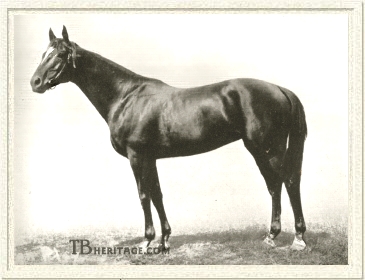 |
|
|
Royally-bred in both sire and dam, Fair Play was one of the best runners of his generation. His subsequent dominance as a sire, and sire of sires, made his golden bloodline one of the premier American strains of the 1900s. The Fair Plays were reknown for their great soundness, stamina, and weight-carrying ability, qualities that made this line one of the most admirable that America would produce.
Breeder August Belmont II purchased Fair Play's sire, Hastings, and dam, *Fairy Gold, both of which became pillars of Belmont's breeding program at Nursery Stud in Kentucky. Bred by Dr. J.D. Neet, Hastings was a son of the champion Spendthrift and out of Neet's blue hen broodmare *Cinderella, whose other foals included the Kentucky Derby winner Plaudit, stakes winners Migraine, Glenheim, and Ferrier, and the filly Slippers (dam of Preakness winner Buskin and the broodmare Polly Flinders). In foaling both Hastings, who won the Belmont Stakes, and Plaudit, who won the Kentucky Derby, *Cinderella is one of the rare mares to have produced 2 American classic winners, and also 2 successful sires whose male lines have survived into current times (Hastings' through War Relic and Plaudit's through Rough'n Tumble).
|

Fair Play's grandsire, Spendthrift

Fair Play's sire, Hastings, by Spendthrift
| |
In 1895, Belmont purchased the stakes-winnning 2-year-old Hastings for $37,000, with the intention of winning the Futurity, at the time the richest race for juveniles in America. Requital won the feature with Hastings a disappointing fifth, but the following season, Hastings won the prestigious Belmont Stakes (then run at 9 furlongs), the first of 5 wins in this classic, which had been named for Belmont's father. That year, Hastings also won the Toboggan Handicap, a 6 furlong sprint, which was more to his liking distance-wise. At 4, Hastings proved himself more of a sprinter, dead-heating for first with champion handicapper Clifford in the Kearney Handicap, besides winning handicaps at 5, 6, and 7 furlongs.
As he matured, Hastings began to show exteme symptoms of his dam's foul temperament, which became a trademark of the bloodline descending from him. Although Spendthrift himself was a good-natured horse, the sireline had also produced it's share of notorious individuals, including the ancestors Comus and Humphrey Clinker. In Giants of the Turf, Dan Bowmar noted "As a stallion, Hastings refused to allow a bridle to be put on him, and his groom carried a large stick whenever the horse had to be caught. After a few close calls, a runway was built from Hastings' stall to his paddock so that handling would be reduced to a minimum." |
| Retired to the Nursery Stud in 1898, Hastings' first crop raced in 1901, and he was an immediate success. He was America's Leading Sire in 1902 and again in 1908. Although his forte was really precocious juveniles, more than a few improved with age. His first crop included Belmont Stakes winner Masterman as well as the champion handicap mare Gunfire. As a virtually private stallion for Belmont, he sired 289 foals, with 51 becoming stakes winners. The best of these was Fair Play, who led the 1908 barrage of runners which earned their sire his second Leading Sire title. Besides Fair Play, Masterman and Gunfire, Hastings also sired the Preakness Stakes winner Don Enrique, Withers Stakes winner Blandy, Kentucky Oaks winner Flamma, plus Glorifier, Tiptoe, and Achievement among his best. Hastings died at the age of 24, late in 1917, the year his greatest legacy was born, his grandson Man o'War. |

Fair Play's dam, Fairy Gold
| |
In 1904, Hastings covered the English-bred mare *Fairy Gold (1896), which August Belmont II had purchased and imported in 1903. *Fairy Gold had been bred by Russell Swanwick and raced for Leonard Cohen, for whom she won the Woodcote Stakes at Epsom as a 2-year-old among her 3 turf victories. Her first foal was St. Lucre (1901 by St. Serf), later the dam of stakes winner Zariba (dam herself of Marcel Boussac's top winners Corrida, Goya II, Abjer, Goyescas, and L'Esperance). Fairy Gold's second foal was the excellent stayer Golden Measure (1902 by Florizel II), winner of the Ascot Gold Vase, Salisbury Cup, and Ebor Handicap. These were her only offspring foaled in England. |
Belmont purchased *Fairy Gold in the summer of 1903 for 3,600 guineas and brought her to Kentucky that same year. In 1905, she produced a golden chestnut colt by Hastings which Belmont named Fair Play. If that had been the end of her production record, she would still have been considered a tremendous asset, but her later foals included Fair Play's full sister Golden View (1906; dam of Rock Flint), his full brother the stakes winner Flittergold (1911), and 2 half-brothers, the outstanding champion and Belmont Stakes winner Friar Rock (1913 by *Rock Sand), and stakes winner Fair Gain (1917 by *Vulcain).
Fair Play on the Turf
Fair Play was trained by Andrew Joyner, and in 10 starts at 2, he won 3 times including the Montauk Stakes and the Flash Stakes at Saratoga. He was also second 3 times, in the Hopeful Stakes (which he lost to Jim Gaffney), Produce Stakes, and Matron Stakes. He was third in the Nursery Handicap and United States Hotel Stakes, in the latter to Restigouche, owned by James R. Keene, whose juggernaut stable also included the 2 leaders of the crop, Colin and Celt. Colin had already demonstrated his vast superiority over the rest of the juveniles, going undefeated in 12 starts, and had beaten Fair Play in the Produce, Matron, and Futurity (Fair Play was fourth).
As a 3-year-old, Colin continued his unbeaten streak in the Withers, Belmont Stakes, and Tidal Handicap. Fair Play's record was more substantial that season, with 16 starts and 7 wins at 3. He was second in his first 5 starts, twice to Colin, in both the Withers (a mile) and Belmont (11 furlongs). In the latter race, Fair Play forced Colin to a furious head victory in a driving rainstorm. Colin was said to have bowed one or both tendons in the effort and the Tidal finished him for the season. On the other hand, Fair Play proved more sound and resilient, bouncing back to run second in the Brooklyn Handicap just 2 days after the Belmont behind Celt, who set a new track record for the 10 furlongs (2:04 1/5) in the process.
The Hastings colt followed up with a win in the Brooklyn Derby (later renamed the Dwyer Stakes) run at a mile and a half. In his next start, Fair Play finished third behind the mighty handicapper Ballot in the Suburban Handicap at a mile and a quarter. Fair Play's other wins included the Coney Island Jockey Club Stakes (defeating Hessian and King James), the Lawrence Realization (a staying test at 13 furlongs, defeating King James and Dorante), Jerome Handicap (setting a new track record for 10.5 furlongs at Belmont), Municipal Handicap, and First Special (setting a new track record at Gravesend for 10 furlongs in 2:03 2/5).
Late in 1908, racing was shut down in New York due to anti-gambling laws, and many of the top stables sent their best runners to race in England, including those owned by James R. Keene and August Belmont. Colin and Fair Play were both shipped overseas (along with Ballot, etc.), but neither covered himself with glory. Colin broke down before he could start in England and retired to stud there. Fair Play, based at Balaton Lodge in Newmarket, raced 6 times in England but showed nothing. He did not adjust well to training on grass and was forced to carry extremely high weights. Either or both soured him, exacerbated by the onset of his sire's bad temperament, and ultimately, he refused to run altogether. Fair Play was returned to America in the fall of 1909 with the intent to continue to race him, but his attitude only worsened and his record closed with 10 wins in 32 starts, 11 seconds, 3 thirds and $86,950 in earnings.
Fair Play at Stud
Fair Play was entered stud at his birthplace, Nursery Stud in Kentucky for the 1910 breeding season. Here he joined Hastings, Ethelbert, Henry of Navarre, and a recent Belmont acquisition, the English Triple Crown winner *Rock Sand, who covered his first American mares in 1907. Daughters of *Rock Sand were to become a fortuitous nick for Fair Play, although none had reached the broodmare stage as yet. |
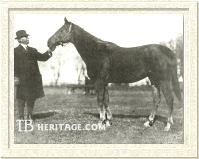
Stromboli
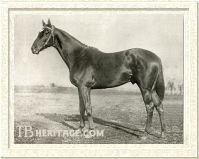
Man o' War
| |
The premier crop by Fair Play included stakes winners SUN KING, ROBINETTA, FLITAWAY, and STROMBOLI, the latter a gelding who improved with age and became one of the country's top handicappers. In all, Fair Play sired 49 stakes winners from 260 foals.
His very best runner was a horse for the ages, the mighty MAN O'WAR (1917 out of Mahubah by *Rock Sand), whose exploits as a 3-year-old in 1920 took Fair Play to the top of the Leading Sires list for the first of 3 sire championships (Fair Play also led the sires in 1924 and 1927). Man o'War won the Preakness, Belmont, Withers, Dwyer, and numerous other top events, ending with a victorious romp over the older champion Sir Barton in the Kenilworth Gold Cup in November of 1920. He won with style and ease, shattering time records and leaving the crowds breathless.
At stud, Man o'War sired 64 stakes winners, beginning with champions American Flag, Florence Nightingale and Maid At Arms in his first crop. Man o'War became a leading sire himself, in 1926, when his great son Crusader dominated the scene, along with champion filly Edith Cavell and Travers winner Mars. |
Later crops produced the Triple Crown winner War Admiral, champion mare Bateau, Kentucky Derby winner Clyde Van Dusen, champion steeplechaser Battleship, champion 2-year-old Scapa Flow, War Glory, and the good colt War Relic, who beat Whirlaway. American Flag, War Glory, War Admiral, and War Relic were all good sires, although most, because of their stamina, tended to be better sires of broodmares. War Admiral was America's Leading Sire in 1945, the fourth generation of this male line to win the honor since Hastings in 1902. War Relic's sons Relic and Intent carried the Fair Play male line into the 21st Century.
Man o'War, who had been bred by Belmont but sold as a yearling to Samuel Riddle, was one of 5 Belmont Stakes winners created by his breeder, and 2 of those were sired by Fair Play (the other was Chance Shot, in 1927), whose offspring got better with age and distance. |
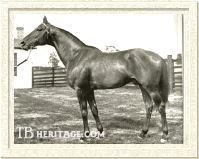
Mad Hatter
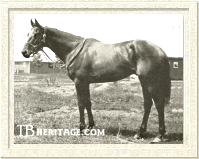
Display
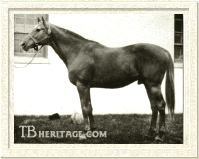
Chance Play
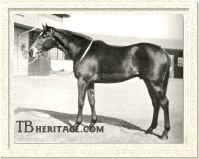
Chance Shot

Chatterton
| |
Fair Play's erratic son MAD HATTER (1916 out of Madcap) was born a year before Man o'War and also foaled from a daughter of *Rock Sand. Later-maturing, he had a championship year at the age of 6 when he won the Jockey Club Gold Cup and Metropolitan Handicap, and in later seasons picked up victories in the Toboggan, Suburban, and Queens County Handicaps. Mad Hatter's younger brother Mad Play (1921) won the Belmont Stakes at 3 and the Brooklyn Handicap and Saratoga Cup at 4. Both were infertile horses, Mad Play was completely sterile, while Mad Hatter managed to sire some good stock in the champion filly Snowflake (C.C.A. Oaks), the good handicapper The Nut, and the dams of Sunglow, Flying Lee, and Porter's Cap. Mad Hatter's sons The Nut and Cocked Hat (sire of Opera Hat) bred on another generation or two.
Fair Play's son DISPLAY (out of Cicuta by *Nassovian) won the Preakness in 1926 but earned a stronger reputation as a stayer and the "Iron Horse" in the handicap ranks at 4, 5, and 6. Bred by Walter J. Salmon, he was one of the few Fair Plays not bred at Nursery Stud, and also one of the few without a cross of *Rock Sand in his dam. He was an extremely difficult horse with a dangerous temperament, but did well as a stallion at Mereworth Farm. His son Discovery (1931) was a top handicapper and became a tremendous broodmare sire. Display also did well as a brodmare sire. His daughter Dark Display produced the intensely inbred (to Fair Play) champion colt Battlefield, another head case, and also appears in the dam of Storm Bird. Quivira was the dam of Lochinvar and granddam of champion Dedicate. Cherry Orchard produced the champion steeplechaser Jam. His other important daughters include Parade Girl, Fast Stride, Flyaway Home, and Bramble Bug.
The brothers CHANCE PLAY (1923) and CHANCE SHOT (1924) were top class both on the track and at stud. Out of Belmont's mare Quelle Chance, by Ethelbert, their second dam was the French Oaks winner Qu'Elle Est Belle II by *Rock Sand. Chance Play was a good stakes winner at 3, and was second only to Crusader as a 4-year-old; with victories including the Saratoga Cup and Jockey Club Gold Cup (through disqualification of Brown Bud). He first entered stud in New York and was later moved to Calumet Farm. Chance Play was America's Leading Sire 2 times, in 1935 and 1944, and sired such good ones as champion juvenile filly Now What, Pot O' Luck, Psychic Bid, Grand Slam, and Some Chance. Grand Slam and Some Chance became good sires. Pot O' Luck left a French daughter Floralie, who appears in the dam line of sires Dalsaan and Doyoun. Chance Play's daughter Now What produced champion Next Move; and other daughters produced the classy Queen Hopeful and Royal Bay Gem.
Chance Shot was a stakes winner at 2, and at 3 won the Belmont Stakes and Wither Stakes. At 4 he was a good handicapper, and retired to stud at Elmendorf Stud in 1930 to replace his sire, Fair Play, who had died there in 1929. Chance Shot sired Belmont Stakes winner Peace Chance (sire of Arbitrator, the dam of the top broodmare Almahmoud), the champion filly Fairy Chant, Futurity winner Chance Sun, as well as Bushwacker, Shot Put, and Your Chance.
|
Unlike brother Chance Play, who had several sons excel as sires, Chance Shot's daughters proved better, and produced champions Honeymoon, Armed, and American Way (a steeplechaser).
Fair Play's minor stakes winner CHATTERTON (1919 out of Chit Chat by *Rock Sand) became the Leading Sire of 1932 when his son Faireno was the champion 3-year-old, and won the Belmont Stakes. Man o'War's full brother MY PLAY (1919) won the Jockey Club Gold Cup as a 5-year-old and sired the Preakness winner Head Play, as well as Plucky Play (sire), Playdale (sire), and the mares Gentle Play, My Tide, and Xanthina. Fair Play's son LADKIN (1921) won the Dwyer Stakes and was one of Belmont's favorites.
He sired Ladala (dam of the top broodmare Accra), Lady Higloss (granddam of Hill Gail), and the stakes winner Ladder, who sired the Canadian champion Bunty Lawless from only 3 foals.
The Fair Play tribe were excellent jumpers. Many of his sons and grandsons were successful steeplechasers and hurdlers. The best of these was the champion and Hall of Fame Steeplechaser FAIRMOUNT (1921) who won the Temple Gwathmey Memorial Steeplechase 3 years in a row at 5, 6, and 7 years of age. |

Fairday, right, produced good handicapper Inseparable and 3 other stakes winners; Wayabout, left, produced Bolingbroke and Whiffenpoof.
| |
Belmont raced only a few of Fair Play's daughters, and the best was probably HOW FAIR (1920) winner of the Coaching Club American Oaks. Just as his sons excelled as sires, Fair Play's daughters were outstanding broodmares, and he was the Leading Broodmare Sire 3 times, in 1931, when his grandson Sun Beau (by *Sun Briar) became the world's leading money winner; in 1934, when grandson High Quest (by *Sir Gallahad III) won the Preakness and Wood Memorial, and in 1938, when grandson Stagehand (by *Sickle) was the champion among 3-year-olds. Other good ones out of daughters of Fair Play were the champions Valenciennes, Jamestown, Fair Star, and the top handicappers Time Supply and Bolingbroke. Triple Crown winner Assault traces back in female line to Masda, a Fair Play daughter and full sister to Man o'War. |
Fair Play's breeder and owner August Belmont died in 1924 and his Nursery Stud was put up for bid in stages. At the final dispersal sale of bloodstock, the 19-year-old Fair Play was purchased by Joseph E. Widener for $100,000 and moved to Widener's Elmendorf Stud, on the Paris Pike. Fair Play died in December of 1929, when 24 years old. Widener buried him on a lovely wooded plot of land that became the farm's horse cemetery, and erected a nearly life-size bronze statue of Fair Play overlooking the graves of the stallion and his "wife" Mahubah (who had died in 1931 and was buried beside him).
Physically, Fair Play was a throwback to his dam's side of the pedigree, bearing a strong resemblence to *Fairy Gold's sire Bend Or, and he was also said to be a close copy of Hermit, the sire of his second dam, Pauline. All three, Fair Play, Bend Or, and Hermit, were stylish, lengthy golden chesnuts built in the mold of the stayer. Fair Play stood a leggy 15.3 hands, with a good shoulder, and excellent hindquarter and hind leg. He had none of Hasting's curby sickle hocks. Fair Play was tastefully marked with a large elongated star on his face but was otherwise wholly colored, with no white on his legs. He tended to pass on his few "Bend Or spots," small, dark ovoid-shaped spots. The bronze statue in the Widener horse cemetery (now on Normandy Farm) faithfully reflects Fair Play's high-headed, imperious presence, which stamped generations of horses that followed him.
--Anne Peters
|
|
|
|

